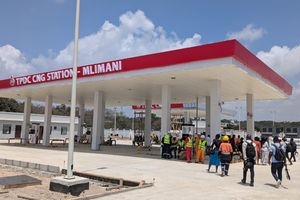South Sudanese may disagree on what fuels conflict but agree graft is at the root of it all

What you need to know:
Corruption, whether monetary, political or moral, became the death knell to the country’s hard won “unity, equality and progress,” SPLA’s motto. Corruption and violence pushed four million citizens into refuge.
One thing that has not been clearly delineated about violence in South Sudan is the role of corruption as a most insidious driver of the ghastly inequities that have now come to characterise the young state as one of the most unequal societies in Africa.
And it is these inequities that underpin the violent confrontations that have plagued South Sudan for many years, dating back to the period of the liberation struggle (1983 to 2005).
Corruption and the conflicts that it inspires are linked to a history of predation by competing armed groups within the liberation effort.
They are attributed primarily to political elites’ competition for power and control of resources, starting long before South Sudan seceded from Sudan in 2011.
The Sudan Peoples’ Liberation Army (SPLA) that championed South Sudan’s liberation cause applied predatory practices as a way to get the population to pay the cost of liberation war.
This approach is remembered throughout South Sudan as the time when the chickens, goats and cows were taken by force and eaten.
This left behind a strong legacy of violence against civilians as a method of governance, even when the region became a country.
ABSENCE OF JUSTICE
Elite confrontations at the national level are often matched by ethnic feuds from below, between the country’s many ethnic groups, often triggered by everyday matters of survival, competition over natural resources and absence of justice.
This is what has sustained cycles of violent revenge attacks as a form of recompense.
These communal feuds feed into and off of the national level political wrangling, to form a deadly nexus between political aspirations of elites and the impoverishment and vulnerability of their constituencies at the grass roots.
Even when a violent attack takes place in what seems to be a cycle of tribal feuds over resources, it is often more likely sponsored by an SPLA general, an absentee property owner, or by a politician pitting his community against another.
The fuel for these cycles of violence is corruption, one perpetrated by the elite.
If these factors may be painfully true, it is the theft and mismanagement of the country’s resources that is the crux of the deadly violence that has made South Sudan a fragile country.
It’s misuse, theft, siphoning off of the country’s wealth and entrenchment of corrupt practices as the rule, that will sustain the violence, which will likely get worse before the situation can get better.
South Sudanese may disagree on many factors that drive the conflicts, but not on the extent of corruption as the root of all evil in the country.
How does corruption link to violence, though?
When the liberation war ended in 2005 the freedom fighters took the helms of power. They also took control of the oil revenues. The money came into their hands at a time when there were no institutions and skilled personnel to handle such vast resources and everyone with a hand in the money pot went on a shopping spree.
Few of them thought to account for these large sums, for they had “liberated” the country and were entitled to it. They had put in two decades of their lives. They had been poor, unhealthy and getting old, what better things to do with peoples’ money than to cushion themselves and their children?
They were also unsure about future stability of the country and the best insurance against the unknown was to move money out of the country and into the neighbouring countries.
But the more money they sent outside the more instability they caused. Within a brief period of time, some $4 billion went unaccounted for and what had been a middle-income country at the time of independence was $4.5 billion in the red by the time the civil war broke out in late 2013, a mere one and half years of “liberators’” chest pounding.
UNPAID FOR MONTHS
The SPLA, the new country’s defence forces and the largest most expensive institution, consuming over 40 per cent of the country’s total expenditure by official accounts, became a bottomless money pit and yet, the soldiers went unpaid for months on end, pushing some of them into life of crime or into anti-government militias.
It was downhill from there for the young state. Everything the doomsday predictors had said, that South Sudan would suffer the Dutch Disease, that ethnic wrangling and nepotism would bring disunity, that Africa’s liberators’ syndrome would kick in, all became true.
The SPLM, the liberation movement turned ruling party, could not be questioned by anyone, or was asked “where were you when we fought to liberate this country?”
In the 2010 elections, SPLM stole gubernatorial and parliamentary votes in favour of members closest to the top leadership. This pushed many people into rebellion, including some of the most memorable liberation heroes like George Athor Deng and Dau Aturjong. Others rebelled to protest exclusion from the gains of autonomy.
Corruption, whether monetary, political or moral, became the death knell to the country’s hard won “unity, equality and progress,” SPLA’s motto. Corruption and violence pushed four million citizens into refuge. A true liberator would ask himself what he had sacrificed his youth for.
SECURITY
President Salva Kiir Mayardit asked himself this question but has fallen short of answering it. Between 2010 and 2013, he took momentous steps in ensuring that security was restored. In 2010 he invited every armed group to join the government and help prepare for the referendum on unity with Sudan or separation, scheduled for January 2011.
Most groups responded positively to what became known as the “big tent” policy, reaching peace deals with rebel movements and reintegrating them into the SPLA. But these were short-lived. Integrating these forces into national army became the biggest conduit for grand theft. Numbers of absorbed soldiers and the military ranks were inflated.
The SPLA’s departments of administration, finance and procurement became the gravy train that everyone wanted to ride.
This ugly form of corruption meant the country could not provide basic services, especially the highly expected security, education and healthcare.
What is the way out? We must first recognise that corruption of that nature does not happen in a vacuum. It happens in a climate where political leaders and the country’s entire system thrive on corruption.
Leila Jok Madut Jok is a professor of anthropology at Maxwell School of Citizenship and Public Affairs, Syracuse University.




